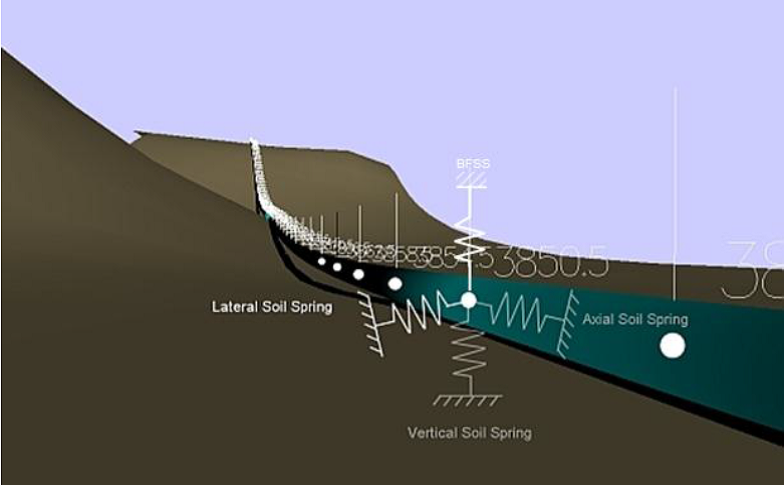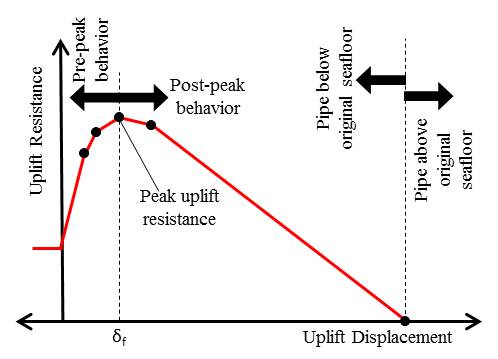At OMAE2015 in St. John’s (CAN), Prigiarto Hokkal Yonatan presented a paper introducing a new technique to assess the risk of upheaval buckling (UHB). This new methodology uses a backfill soil spring (BFSS) attached to the top of the pipe for representing the uplift resistance provided by the backfill soil on top of a buried pipeline. This tool will be available in the brand new SAGE Profile 3.0 to be released in the summer of this year!
Abstract: Numerical Simulation Of Upheaval Buckling Using Intelligent Backfill Soil Spring.
Prigiarto Hokkal Yonatan, Filip Van den Abeele and Jean-Christophe Ballard, Fugro GeoConsulting Belgium
Designing the cover height of buried pipelines to prevent them from buckling requires a method that can thoroughly and realistically model the phenomenon. This paper introduces a new technique to assess the risk of upheaval buckling (UHB) by using backfill soil springs (BFSS) to represent the uplift resistance provided by the backfill soil on top of a buried pipeline. This paper investigates the pre-buckling pipeline behavior related to UHB and highlights some of the key parameters governing the analysis. UHB assessment based on a case study was carried out and the results were then compared with those obtained from force-equilibrium methods generally used in the industry. The comparison shows that UHB assessment can be performed more rigorous using BFSS than using force-equilibrium methods. Therefore, using BFSS for UHB assessment improve the reliability in cover height design.
Predicting the risk of upheaval buckling (UHB) of buried subsea pipelines remains a challenge within the oil and gas industry because of the many inherent uncertainties associated with this mechanism. The phenomenon is caused by the pipeline’s out-of-straightness combined with the high axial compressive force induced by the extreme operational conditions.
If the pipeline is not sufficiently buried, it will eventually cause the pipeline to resurface at the seabed. This can cause considerable operational problems for the operators and for the fishing industry, while the cost implications associated with repairing the pipeline are significant. On the other hand, if the methods used to assess the risk of UHB and design the required cover height are too conservative, this will result in a costly design due to additional costs caused by deeper trenching or additional rock dumping. Therefore, there is a need to model UHB as efficiently and accurately as possible.
This paper introduces a new technique to assess the risk of upheaval buckling (UHB) by using a backfill soil spring (BFSS), which is an independent spring attached to the top of the pipe for representing the uplift resistance provided by the backfill soil on top of a buried pipeline. The key advantage of using BFSS in assessing UHB is that the uplift spring can be customized and the response during UHB can be monitored. This leads to a more rigorous analysis and confidence in the cover height design.
Representation of the four soil springs used by SAGE Profile
This paper investigates the pre-buckling pipeline behavior related to UHB and highlights some of the key parameters governing the analysis. UHB assessments based on a case study were carried out and the results were compared with those obtained from traditional force-equilibrium methods. The comparison shows that UHB assessment can be performed more rigorously using BFSS than using force-equilibrium methods. Therefore, using BFSS for UHB assessment improves the reliability in cover height design.
SAGE Profile 3.0 will offer a set of new tools for performing such UHB analyses. The brand new trenching module will allow simulating the process of cutting the seabed, lowering down the pipeline in the trench, and subsequently backfilling. During the backfilling process, a BFSS will possibly be activated, allowing to predict the susceptibility of buried pipelines to upheaval buckling.
Backfill Soil Spring definition curve


